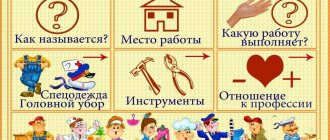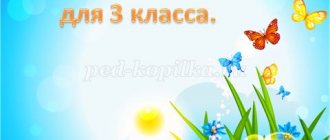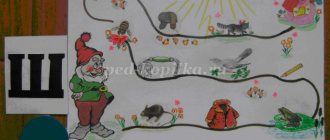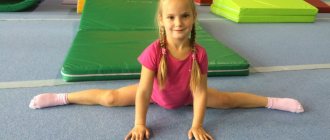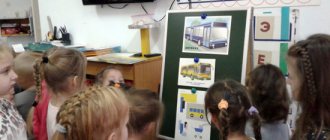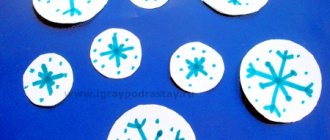DOWNLOAD PRESENTATION
Developed by a teacher-speech therapistVasilyeva Elvira Gennadievna
Cheboksary special (correctional) primary school-kindergarten No. 3 “Nadezhda” of the Chuvash Republic
slide 1
Goal: developing ideas about the content side of sentences to ensure its semantic completeness and communicative expediency
Tasks:
Educational:
1) developing the ability to determine the number and sequence of words in a sentence;
2) consolidation of the skill of grammatical formatting of sentences, coordination of words in a sentence;
3) differentiation of prepositions and prefixes,
Corrective:
4) development of logical thinking, memory, attention;
5) correction of fine and gross motor skills
Educational:
- developing a sense of responsibility and self-confidence;
- formation of personal qualities;
- cultivating a sense of respect for adults, the ability to communicate with teachers and children in a team
Equipment: screen, projector, computer, task cards, notebooks
Progress of the lesson
- Organizing time.
1. Development of visual perception and visual gnosis.
Speech therapist: Guys, what objects are shown on the slide? (frog, reeds, dragonfly - overlaid images) What are words made of? (from syllables)
How many syllables are in each of these words? (3)
slide 2
- Making proposals based on guessed pictures.
Speech therapist: What is a sentence? (words related to each other in meaning)
Make up a sentence with words - names of pictures. (The frog sat in the reeds and looked at the dragonfly.)
Speech therapist: How many words are there in your sentence?
- Formulating the topic of the lesson.
Speech therapist: Who guessed what we will do in class? (work with suggestions)
- Main part
1. Meet the hero.
Speech therapist: We received a mysterious letter. Review the recording. Try to decipher this letter and read it, then you will find out who wrote it. (There is a note on the cards, words in brackets are replaced with pictures)
Text of the letter: I have a (barrel) of honey. There is also a (jar) of jam. I will soon (come) to visit you and bring you a treat. (Winnie the Pooh)
slide 3
- Restoring deformed sentences.
Speech therapist: Winnie the Pooh loves honey very much, but the bees don’t let him get enough of it. Let's help Winnie the Pooh.
slide 4
Speech therapist: Make up sentences from the words the bees brought. Write down the resulting sentences.
Words: - it was summer, sultry (It was sultry summer.)
- jackdaw, on, fence, sat down (A jackdaw sat down on the fence.)
- Kolya, I asked a riddle (Kolya asked a riddle.)
- cat, attic, on, climbed (The cat climbed into the attic.)
- in, flooded, yard, skating rink, big, flooded (In the yard, the children flooded a large skating rink.)
Physical exercise for the eyes ( Masko ophthalmic simulator)
slide 5
- Establishing logical connections between words within sentences.
Speech therapist: Do you know Winnie the Pooh’s friends? (Piglet, Tigger, Eeyore, etc.)
slide 6
Tigger got naughty and rearranged the words in the sentences. Let's together correct logical errors and write the sentences correctly.
slide 7
— In the spring, the meadows flooded the river.
— The goat gave the girl water to drink.
— After summer, the long-awaited spring came.
Speech therapist: Tigger is pleased with your help. He will definitely tell Piglet about this.
slide 8
But suddenly impudent and hungry crows flew at Piglet.
Speech therapist: How to drive them away? (put up a scarecrow, shoot with a slingshot). Yes. But there is another method - birds do not like to exercise. Let's all start doing exercises together with Piglet, Tigger and Winnie the Pooh - the crows will immediately fly away.
slide 9
Physical exercise (with movements)
- Differentiation of prepositions and prefixes in sentences. Strengthening the skill of agreeing words in a sentence.
Speech therapist: The friends were having so much fun that they didn’t notice Eeyore. He is upset: the crows took some words with them. Eeyore just can't cope.
Speech therapist: Let's help the donkey Eeyore: complete the sentences by inserting words that suit their meaning. Think about how to correctly write small words in brackets - together or separately? What is the difference between a preposition and a prefix? (you can insert another word between the preposition and the word). Let's underline the spelling.
slide 10
________ (boy) ran (along) the garden path
_________ (from) swam (from) the shore. (Boat)
Zhenya _________ (on) wrote (on) the address on the envelope. (Petrov)
5. Training in determining the boundaries of sentences.
Speech therapist: While we were choosing words, a wise owl appeared in the clearing. She brought a letter from Christopher Robin .
slide 11
Speech therapist: The owl wrote down everything that the boy wanted to convey to his friends. See why it is difficult to read a letter? What did the owl forget? (put punctuation marks). When should you put a period at the end of a sentence? (when the thought is over)
Speech therapist: Let's correct the mistakes made by the owl. Read and write the text correctly.
Text of the letter:
A fresh breeze blew, the sun rose, the birds sang loudly, who is it that is pouring in the raspberry bushes, how the dew drops glisten, how beautiful the forest is at dawn.
slide 12
Speech therapist: What sentences are found in the text regarding the purpose of the statement? What punctuation did you use? (?, !, .)
Speech therapist: Read the fifth sentence with Eeyore, the first sentence with Winnie the Pooh, and the last sentence from Christopher Robin’s letter with Tigger.
- Summarizing. slide 13
Speech therapist: What is a sentence? Text?
What was difficult in the lesson and what was easy?
TOPIC: "Fairytale Journey".
Goals
: practicing the ability to compose a common sentence based on a plot picture and supporting words, using “words-objects”, “words-features” and “words-actions”.
Planned results:
Subject:
– consolidate the ability to make a common sentence based on a picture;
– develop all types of speech activity of schoolchildren, the ability to read and write, listen and speak, as well as freely use their native language in various communication situations. Metasubject:
- develop coherent speech, auditory attention, phonemic perception, thinking, visual, figurative memory, fine motor skills;
- develop dialogic speech, speech breathing, articulatory apparatus;
- develop the ability to answer questions clearly and competently.
Personal:
- cultivate love and interest in fairy tales;
- develop cooperation skills: the ability to work in a team;
- to unite the children's team, to show the importance of each student in the unified work of the class.
Expected Result
:
Students will learn to form common sentences.
Health-saving technologies: exercises and games for coordinating speech with movement, finger exercises, breathing exercises.
Equipment : PC, presentation “Composing common sentences”, pencils, notebook, envelopes with words, personal mirror, evaluative emoticons.
Progress of the lesson:
1. Organizational moment.
Speech therapist:
We will sit in a circle together, We need to say hello. I say “Hello!” Smile back quickly. Hello right hand, Hello left hand, Hello friend, hello friend, Hello our entire friendly circle.
Speech therapist: Guys, look, we have guests today. Let's smile at our guests!
Today we have an unusual activity. We will go on a journey to a fairyland. Do you want to come with me?
Children: Yes.
Speech therapist: Then listen. In a certain kingdom, in a certain state, an evil witch has driven many clouds into the sky, and for days now the sun has not been seen, it has been raining. The King was saddened. Only brave, courageous knights can help lift the evil curse. Let's help the people of this country return the sun. To do this, you need to pass the test by completing all the tasks correctly. You are ready?
Children: Yes.
Speech therapist: Then let's start.
